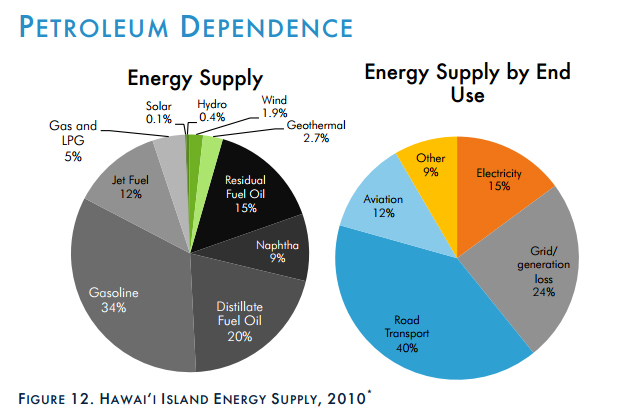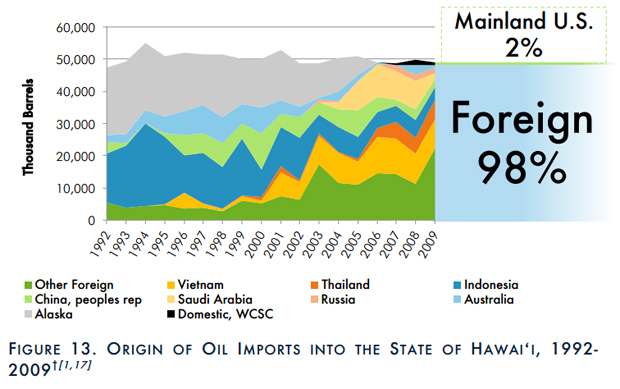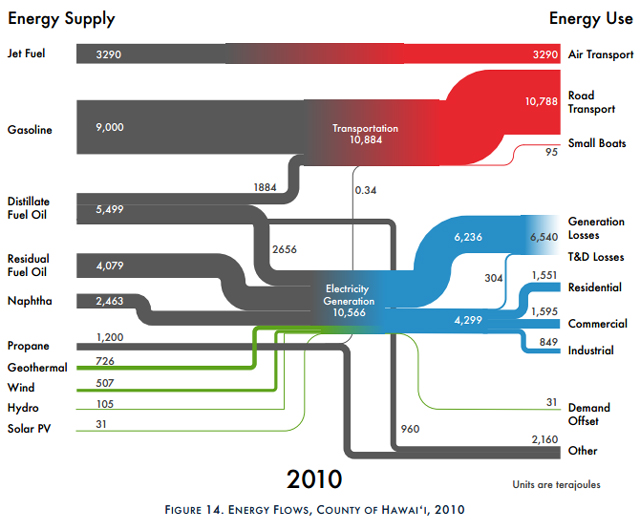By David Corrigan
HAWAII ISLAND: A draft of the County of Hawai‘i Energy Sustainability Program Five Year Roadmap is now available for public review and comment. The extensive document drafted by The Kohala Center aims to increase energy self reliance and taxpayer savings.
From the media release issued by the Kohala Center on Friday:
| … The Roadmap recommends County actions that will save significant taxpayer dollars, while empowering the County government to lead the transition to energy sustainability. Successful implementation will position Hawai‘i County to assume a proactive leadership role at critical state-level energy policy proceedings, including those of the Public Utilities Commission and the Legislature.The Energy Sustainability Roadmap also updates the County of Hawai‘i Energy Baseline study, sponsored by The Kohala Center in 2006. The Roadmap demonstrates that electricity is only part of the total energy consumption on the island. |
Using data from 2010, the draft reports that Hawaii Island consumed about 26,899 terajoules (TJ) of energy; the report explains one terajoule is equal to 1 trillion joules, or about 948 million Btu, British thermal units. The energy consumption is mostly in the form of liquid, petroleum-derived fuels such as motor gasoline, distillate fuel oil (diesel), naphtha, residual fuel oil, aviation fuels, and liquefied petroleum gas (LPG).
The report reflects on the paltry use of locally produced, renewable energy sources:
| Just 5% of the energy needs of Hawai‘i Island’s residents, businesses, and visitors are met through locally produced renewable energy sources.Hawai‘i Island does have abundant renewable energy resources, such as solar, wind, geothermal, and bioenergy; however, the current energy system makes comparatively little use of these local supplies. Only about 1,369 TJ of the island’s energy supply consists of electricity produced from geothermal, wind, solar, and hydropower resources. Hawai‘i Island’s overwhelming dependence on petroleum products is the fundamental reason for pursuing energy sustainability. |
| Hawai‘i Island has no fossil fuel resources, so almost every barrel of petroleum that makes up the remaining 95% of the energy supply is imported into the state from international sources far from the islands (Figure 13). Most of the petroleum products consumed in the State of Hawai‘i are refined locally at the two refineries on O‘ahu, owned and operated by Chevron and Tesoro. Direct imports of refined products account for less than 10% of total fuel imported into the state, by volume.While the rest of the United States is similarly reliant on fossil fuels, the mainland’s energy supply is more diversified to include lower cost coal and natural gas. Additionally, the mainland has significant domestic energy resources that supply 55% of the petroleum demand, 95% of the natural gas and nearly 100% of the coal.Hawai‘i Island is exceptional for being almost completely dependent on exclusively on petroleum products from foreign sources. Petroleum prices also have significant impacts on the tourism industry (in the form of aviation fuel prices), which is a major component of the island’s economy. |
The report says a little more than half of the island’s total fuel consumption was used in the transportation sector.
The draft report provides a very interesting graphic depicting the flow of energy from supply to demand for Hawaii Island (below).
| On the left are the energy supplies (all quantities in terajoules). These energy supplies are delivered to the energy system, where some are converted from one form into another, and are eventually consumed by end users, which is shown on the right side of the figure. Table 2 shows the same information in tabular format. The top third of the table shows energy production and imports. The middle third indicates where energy is converted from one form into another (for example, from residual fuel oil into electricity), and the bottom third shows how energy is consumed by end-users. |
The report also analyzes energy prices and expenditures:
| In 2011, the island’s residents, visitors, businesses, and government spend more than $920 million on energy purchases, with electricity and transportation each accounting for about half of the total. Over the past six years, electricity prices have risen by over 40%, while consumption has remained flat. Over the same period, motor gasoline prices have increased over 48% and diesel prices have increased 58%. |
The report details the disparities that exist what consumers pay, which fall mainly along economic lines:
| Disparities in energy expenditures are exacerbated because many of the available cost-saving energy technologies, including those for renewable electricity, energy efficiency, and renewable transportation, are not as affordable to low-income households. For example, a solar PV system may be able to save a household many times the initial cost over its lifetime, but that initial cost could put it out of reach for many residents of the island. In addition, low-income residents often rent their homes, and building owners can be reluctant to purchase energy improvements if the benefits mostly accrue to the tenants.Another important consideration related to equity is the recent change to electric rate structures approved by the Hawai‘i Public Utilities Commission known as “decoupling.” This policy has the effect of putting upward pressure on electric rates as total electricity consumption goes down. The intent is to remove the electric utility’s financial incentive to discourage energy efficiency improvements and customer-sited renewable electricity generation (both of which have the effect of reducing utility sales). Revenue decoupling allows the utility to maintain constant revenues even as customers install renewable technologies and efficiency improvements that reduce their overall electricity purchases from the utility.However, if only wealthier customers are able install solar panels and otherwise reduce electricity purchases, the burden of rising rates (exacerbated under decoupling) will fall disproportionately on low-income customers. Since the utility is permitted to continue to impose limits on the amount of customer-sited or variable generation the system can accommodate, early adopters enjoy cost benefits that may not be available to all utility customers going forward. These limits have already been reached for many parts of Hawai‘i Island. |
The report spends a lot of time examining the transportation sector, which “is not well represented in the major public energy policy and decision-making processes at the state- or county-level.” The Big Island is almost twice as large as all the other Hawaiian Islands combined. The report notes that “most of the island’s major communities are spread around the perimeter of the island, which necessitates an extensive transportation infrastructure” of more than 1,481 miles of public roadways.
The draft report states:
| In 2010, Hawai‘i Island consumed more than 14,000 TJ of energy for transportation. Of the more than 100 million gallons of transportation fuel consumed on the island every year, nearly 80% of that is gasoline. The island consumes more than 200,000 gallons of gasoline every day. |
The report makes a number of recommensations, and provides costs and timelines.
For transportation sector, recommendations are:
- Coordinate the formation of a large fleet owners consortium.
- Fund a comprehensive mass transit strategic plan
- Increase the user-friendliness of Hele-On bus information for riders.
- Provide grant funding to vehicle dealers and repair businesses to acquire and install electric vehicle servicing equipment.
- Create a property tax credit for electric vehicle charging stations.
- Establish a county-wide priority policy for alternative fuels.
- Adopt or develop a biofuels evaluation framework to support County decisionmaking and advocacy that addresses the specific needs of the island.
- Institute a fuel tax schedule for alternative fuels.
- Develop a framework for increasing the fuel tax on fossil fuels at a future date.
- Implement a Complete Streets policy to improve the safety and accessibility of the island’s public roadways.
- Enforce the state law requiring large parking lots to provide electric vehicle parking and charging.
- Reduce fossil-fuel consumption in the County fleet through vehicle purchasing and a fleet management system
- Encourage County employees to use an existing free private platform for carpooling and ridesharing
Recommedations for renewable energy:
- Devote additional resources to representing the County’s interest in Public Utilities Commission proceedings
- Introduce an expedited permitting process for small solar photovoltaic systems.
- Institute a county-level approval process for geothermal exploration and development that ensures a project is not materially detrimental to the public welfare and includes a public hearing
- Expand the definition of the Geothermal Asset Fund and the Geothermal Relocation and Community Benefits Fund to address any future geothermal development
- Release a master request for proposals for renewable energy projects for all public facilities
And for energy efficiency:
- Adopt and maintain strong building energy codes
- Create a building energy performance rating and disclosure program
- Require independent commissioning for all new large commercial construction projects and major renovations
- Restrict the solar water heater tax credit to existing buildings
- Create a revolving fund to capture energy cost savings for reinvestment
- Conduct energy service performance contracting for County facilities
- Establish efficiency standards for County equipment purchases
In it’s conclusion, the road map states:
| The County of Hawai‘i Energy Sustainability Program Five Year Roadmap describes the challenges, highlights the opportunities, and suggests the highest priority actions the County of Hawai‘i can take to lead the island to energy sustainability. By implementing the Priority Actions described in the Roadmap, the County can play a leading role in determining the future of the island’s energy system, protect the interests of island residents, help ensure the appropriate development of the island’s land and other resources, and simultaneously generate significant cost savings to re-invest in a variety of new policies and programs, including returning cost savings to the General Fund to help contribute to all other county programs. The County could save up to $1 million or more per year or more through energy efficiency upgrades to County facilities, installing renewable electricity generation, and introducing a modern fleet management system.The process of entirely transforming the island’s energy system – going from 95% dependency today to 0% dependency – will require the coordinated efforts of thousands of businesses, households, and government agencies throughout the island. The County of Hawai‘i has a key responsibility to help the citizens of the island achieve this formidable challenge. |
The Executive Summary and full Roadmap are available for download and review at http://www.hawaiienergyplan.com. Public comments will be accepted via email at energy@hawaiienergyplan.com, or via telephone by calling (808) 887-6411. For those who wish to review the documents and do not have access to the Internet, please contact The Kohala Center at (808) 887-6411. The public comment period ends on December 5.




by Big Island Video News5:31 pm
on at
STORY SUMMARY
By David Corrigan HAWAII ISLAND: A draft of the County of Hawai‘i Energy Sustainability Program Five Year Roadmap is now available for public review and comment. The extensive document drafted by The Kohala Center aims to increase energy self reliance and taxpayer savings. From the media release issued by the Kohala Center on Friday: … […]